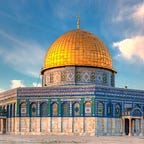The Foundation of Al-Aqsa: Tracing the Historical Events Leading to Its Construction
1. A CONCISE HISTORICAL BACKGROUND….
While Prophet Dawood (A.S) was the ruler, he intended to build a place to house the ‘Tabut-e-Sakina’ or ‘Ark of covenant’ for its safety (since there were many miraculous artifacts and the assets of the Prophets), where people could worship and communicate with Allah. However, he was unable to complete it in his lifetime, and it was finished by his son, Prophet Sulaiman (AS) which came to be known as ‘Haeckel e Suleimani’. Israelites called it as First Temple. The Haeckel was built by in the 10th century BC.
The word “Israel” was named after Hazrat Yaqoob (A.S.), and the followers and descendants of Yaqoob (A.S) are called Bani Israel. The Haikal was simply a house for the worship of God. Tabut E Sakina was placed in the building of Haikal E Sulemani, and the Israelis worshiped Allah, turning their faces towards it.
2. THE DESTRUCTION OF THE HAECKEL / TEMPLE.
- The Babylonian king, known as Bakht E Nasar (King Nebuchadnezzar II), conquered the kingdom of Judah and destroyed the Haeckel in 586 BCE as part of their conquest.
- In 538 BCE, the Persian Empire conquered Babylon, and King Cyrus issued a decree allowing the Jews to return to their homeland and rebuild their Temple. This marked the beginning of the Second Temple (Herod’s Temple) period, which lasted from the rebuilding of the Temple until its destruction by the Romans in 70 CE. Titus was a Roman general who played a significant role in the destruction of the Second Temple.
- After the fall of the Roman Empire, Jerusalem became part of the Byzantine Empire, and the city was ruled by a series of Byzantine emperors.
- Rather than instigating violent assaults on Jerusalem, the Muslim troops surrounded the fort and laid siege to the city. At the time of the siege, Patriarch Sophronius, a representative of the Byzantine government and a leader of the Christian Church, was in charge of Jerusalem. Realizing that resistance was pointless and after a siege of approximately four months, Bishop Sophronius and the Christians in Jerusalem decided to surrender. The Muslim conquest of Jerusalem was bloodless.
However, Sophronius had one condition: he would surrender the keys to the city only if the Caliph Umar ibn Al-Khattab (R.A) came to Jerusalem himself to receive the keys, accept the surrender, and sign a peace pact.
3. CONTRUCTION OF THE AL- AQSA MOSQUE
When Umar (RA) arrived in Palestine with his companions, he could not find the Haeckel. He then prayed near the Masjid E Aqsa, where it is currently located.
Hazrat Umar (RA) quickly transformed the city into a Muslim landmark. He cleared all the areas where Prophet Muhammad (SAWW) had visited during his journey to the heavens. The Christians had been using this area as a garbage dump to offend the Jews, and Umar (RA) cleared the entire region and rebuilt Masjid Al Aqsa in its place.
The reconstruction of the Al-Aqsa Mosque began in the year 705 AD, during the Umayyad caliphate, and was completed in the year 715 AD. The mosque was built by Caliph Abd al-Malik and designed by his son Al-Walid.
4.BREATHING NEW LIFE INTO THE CITY.
Upon conquering Jerusalem in 637, Caliph Umar wasted no time in transforming the city into a significant Muslim landmark. He commenced the clearance of the area of the Temple Mount, which is believed to be the place where Prophet Muhammad ﷺ ascended to heaven from. Previously, the Christians had been using this area as a garbage dump to spite the Jews. Alongside the Jews, Umar and his army cleaned the area and built a mosque known as Masjid al-Aqsa in its place.
Jerusalem continued to thrive as a center of religious pilgrimage and trade under Umar’s caliphate and the Umayyad Empire’s reign over the city. In 691, the Dome of the Rock was added to complement Masjid al-Aqsa, and numerous other mosques and public institutions were established throughout the city.
The Muslim conquest of Jerusalem, particularly under Caliph Umar’s leadership, marked a pivotal moment in the city’s history, and for the next 462 years, it remained under Muslim rule, with minorities’ religious freedom protected under the Treaty of Umar. Today, amidst ongoing conflicts over the city’s future, many Muslims, Christians, and Jews still recognize the Treaty’s legal standing and look to it as a potential solution to Jerusalem’s current problems.
